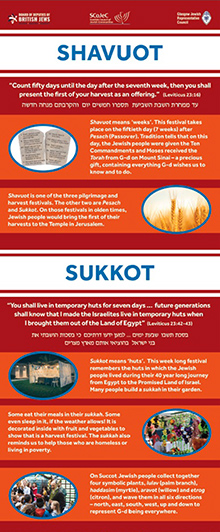|
|
Judaism and the Jewish Community
Jewish Festivals:
Shavuot |
| |
|
| |
|
| |
| |
|
Additional Information |
● |
The festival of Shavuot takes place seven weeks after Pesach. The festival celebrates the giving of the Torah to Moses on Mount Sinai, and to commemorate this, many Jewish people stay up all night to read and learn from the Torah. Many Jewish people also go to the synagogue on the morning of Shavuot to listen to the reading of the Ten Commandments. This is a very important festival for Jews as they believe that the giving of the Torah was the greatest moment of Jewish history. |
● |
Many synagogues are decorated with flowers to recall the tradition that even the mountain itself rejoiced at the giving of the Torah. |
● |
Many Jews read and study the book of Ruth during this time because it is the story of Ruth, a convert, accepting the Torah, just as the Jewish people did. There is also a tradition that that King David, who was descended from Ruth, was born and died on Shavuot. Also Shavuot is also known as the “festival of the first fruits”, and the story of Ruth takes place at harvest time. |
● |
It is traditional to eat dairy foods on Shavuot. |
|
| |

|
| |
Suggested discussion questions and activities |
● |
At Mount Sinai, the Jewish people received the Ten Commandments, ten important rules to help them live together. What is a rule? Why are rules important? Why do you think the Jewish people needed rules after they left Egypt? Do you have family or class rules? What do you think life would be like if there were no rules? Why is it sometimes hard to stick to the rules? |
● |
Discuss growing crops, and how bread is made. Have you ever seen wheat growing in a field? Can you describe it? In ancient times, Jewish people in Israel used to bring the very first sheaves of wheat to the Temple as a way of saying thank you for the good crops. What are some different ways to say “thank you”? Can you make up a special thank you to the farmer, the baker and the shopkeeper who all help so that we can eat bread and other food? |
|
|
● |
Bake a cheesecake or make other dairy food recipes that are traditionally eaten at Shavuot. |
● |
Decorate your school, classroom, or home with flowers in the same way synagogues and homes are traditionally decorated with flowers during Shavuot, or make a collage with flowers and fruit. |
● |
Donate flowers to a local care home to help the residents celebrate this festival. |
● |
Stay up late with a group of friends to tell stories to one another just as Jewish people stay up late on Shavuot to study the Torah. |
● |
Camp out if weather permits, or have an indoor camp, to represent thetime the Jewish people spent travelling in the desert between leaving Egypt and receiving the Torah. |
● |
There is a custom of making beautiful papercuts for Shavuot, often with floral motifs, and these are used to decorate the synagogue. Design and make your own papercut. |
|
| |
Additional Resources |
|
| |
| |
| |
|
|
|